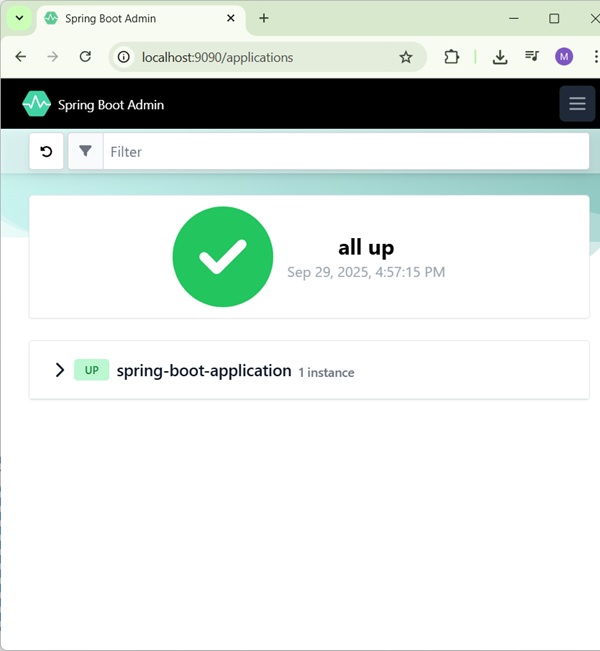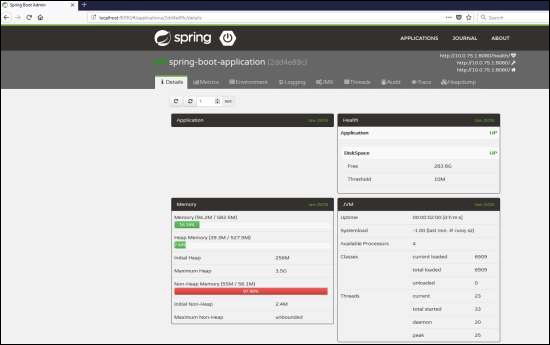
- Spring Boot - Home
- Spring Boot - Introduction
- Spring Boot - Quick Start using CLI
- Spring Boot - Bootstrapping
- Spring Tool Suite
- Spring Boot - Tomcat Deployment
- Spring Boot - Build Systems
- Spring Boot - Code Structure
- Spring Boot - Beans & Dependency Injection
- Spring Boot - Runners
- Spring Boot - Starters
- Spring Boot - Application Properties
- Spring Boot - Configuration
- Spring Boot - Annotations
- Spring Boot - Logging
- Building RESTful Web Services
- Spring Boot - Exception Handling
- Spring Boot - Interceptor
- Spring Boot - Servlet Filter
- Spring Boot - Tomcat Port Number
- Spring Boot - Rest Template
- Spring Boot - File Handling
- Spring Boot - Service Components
- Spring Boot - Thymeleaf
- Consuming RESTful Web Services
- Spring Boot - CORS Support
- Spring Boot - Internationalization
- Spring Boot - Scheduling
- Spring Boot - Enabling HTTPS
- Spring Boot - Eureka Server
- Service Registration with Eureka
- Gateway Proxy Server and Routing
- Spring Cloud Configuration Server
- Spring Cloud Configuration Client
- Spring Boot - Actuator
- Spring Boot - Admin Server
- Spring Boot - Admin Client
- Spring Boot - Enabling Swagger2
- Spring Boot - Using SpringDoc OpenAPI
- Spring Boot - Creating Docker Image
- Tracing Micro Service Logs
- Spring Boot - Flyway Database
- Spring Boot - Sending Email
- Spring Boot - Hystrix
- Spring Boot - Web Socket
- Spring Boot - Batch Service
- Spring Boot - Apache Kafka
- Spring Boot - Twilio
- Spring Boot - Unit Testing
- Rest Controller Unit Testing
- Spring Boot - Database Handling
- Securing Web Applications
- Spring Boot - OAuth2 with JWT
- Spring Boot - Google Cloud Platform
- Spring Boot - Google OAuth2 Sign-In
Spring Boot Resources
Spring Boot - Admin Client
For monitoring and managing your microservice application via Spring Boot Admin Server, you should add the Spring Boot Admin starter client dependency and point out the Admin Server URI into the application properties file.
Note − For monitoring an application, you should enable the Spring Boot Actuator Endpoints for your Microservice application.
For building a Spring Boot Admin Server we need to add the below dependencies in your build configuration file.
Maven users can add the below dependencies in your pom.xml file −
<dependency> <groupId>de.codecentric</groupId> <artifactId>spring-boot-admin-starter-client</artifactId> </dependency> <dependency> <groupId>org.springframework.boot</groupId> <artifactId>spring-boot-starter-actuator</artifactId> </dependency>
Gradle users can add the below dependencies in your build.gradle file −
compile group: 'de.codecentric', name: 'spring-boot-admin-starter-client', version: '3.3.3'
compile('org.springframework.boot:spring-boot-starter-actuator')
Now, add the Spring Boot Admin Server URL into your application properties file.
For properties file users, add the following properties in the application.properties file.
spring.boot.admin.url = http://localhost:9090/
For YAML users, add the following property in application.yml file.
spring:
boot:
admin:
url: http://localhost:9000/
Example - Creating Spring Admin Client
First, download the Spring Boot project from the Spring Initializer page and choose the Spring Admin Client and Spring Boot Actuator. Observe the screenshot given below −

Following is Spring Boot main class.
AdminclientApplication.java
package com.tutorialspoint.adminclient;
import org.springframework.boot.SpringApplication;
import org.springframework.boot.autoconfigure.SpringBootApplication;
@SpringBootApplication
public class AdminclientApplication {
public static void main(String[] args) {
SpringApplication.run(AdminclientApplication.class, args);
}
}
Now, define the admin server url in application.properties file a shown −
spring.boot.admin.client.url=http://localhost:9090 management.endpoints.web.exposure.include=* management.info.env.enabled=true
For YAML users, use the following properties to define the port number and application name in application.yml file.
spring:
application:
name: adminserver
boot:
admin:
client:
url: http://localhost:9090/
The build configuration file is given below.
pom.xml
<?xml version="1.0" encoding="UTF-8"?>
<project xmlns="http://maven.apache.org/POM/4.0.0" xmlns:xsi="http://www.w3.org/2001/XMLSchema-instance"
xsi:schemaLocation="http://maven.apache.org/POM/4.0.0 https://maven.apache.org/xsd/maven-4.0.0.xsd">
<modelVersion>4.0.0</modelVersion>
<parent>
<groupId>org.springframework.boot</groupId>
<artifactId>spring-boot-starter-parent</artifactId>
<version>3.5.6</version>
<relativePath/> <!-- lookup parent from repository -->
</parent>
<groupId>com.tutorialspoint</groupId>
<artifactId>adminclient</artifactId>
<version>0.0.1-SNAPSHOT</version>
<name>adminserver</name>
<description>Demo project for Spring Boot</description>
<url/>
<licenses>
<license/>
</licenses>
<developers>
<developer/>
</developers>
<scm>
<connection/>
<developerConnection/>
<tag/>
<url/>
</scm>
<properties>
<java.version>21</java.version>
<spring-boot-admin.version>3.5.0</spring-boot-admin.version>
</properties>
<dependencies>
<dependency>
<groupId>org.springframework.boot</groupId>
<artifactId>spring-boot-starter-actuator</artifactId>
</dependency>
<dependency>
<groupId>de.codecentric</groupId>
<artifactId>spring-boot-admin-starter-client</artifactId>
</dependency>
<dependency>
<groupId>org.springframework.boot</groupId>
<artifactId>spring-boot-starter-test</artifactId>
<scope>test</scope>
</dependency>
</dependencies>
<dependencyManagement>
<dependencies>
<dependency>
<groupId>de.codecentric</groupId>
<artifactId>spring-boot-admin-dependencies</artifactId>
<version>${spring-boot-admin.version}</version>
<type>pom</type>
<scope>import</scope>
</dependency>
</dependencies>
</dependencyManagement>
<build>
<plugins>
<plugin>
<groupId>org.springframework.boot</groupId>
<artifactId>spring-boot-maven-plugin</artifactId>
</plugin>
</plugins>
</build>
</project>
For Gradle users build.gradle file
buildscript {
ext {
springBootVersion = '3.5.0'
}
repositories {
mavenCentral()
}
dependencies {
classpath("org.springframework.boot:spring-boot-gradle-plugin:${springBootVersion}")
}
}
apply plugin: 'java'
apply plugin: 'eclipse'
apply plugin: 'org.springframework.boot'
group = 'com.tutorialspoint'
version = '0.0.1-SNAPSHOT'
sourceCompatibility = 21
repositories {
mavenCentral()
}
dependencies {
compile('org.springframework.boot:spring-boot-starter')
compile('org.springframework.boot:spring-boot-starter-actuator')
compile group: 'de.codecentric', name: 'spring-boot-admin-client', version: '3.5.0'
testCompile('org.springframework.boot:spring-boot-starter-test')
}
Output
You can create an executable JAR file, and run the Spring Boot application by using the following Maven or Gradle commands −
For Maven, use the command shown here −
mvn clean install
After "BUILD SUCCESS", you can find the JAR file under target directory.
For Gradle, use the command shown here −
gradle clean build
After "BUILD SUCCESSFUL", you can find the JAR file under build/libs directory.
Now, run the JAR file by using the command given below −
java jar <JARFILE>
Now, the application has started on the Tomcat port 9090 as shown here −
. ____ _ __ _ _ /\\ / ___'_ __ _ _(_)_ __ __ _ \ \ \ \ ( ( )\___ | '_ | '_| | '_ \/ _` | \ \ \ \ \\/ ___)| |_)| | | | | || (_| | ) ) ) ) ' |____| .__|_| |_|_| |_\__, | / / / / =========|_|==============|___/=/_/_/_/ :: Spring Boot :: (v3.5.6) 2025-09-29T16:54:57.381+05:30 INFO 16572 --- [ main] c.e.adminclient.AdminclientApplication : Starting AdminclientApplication using Java 21.0.6 with PID 16572 (D:\Projects\adminclient\target\classes started by mahes in D:\Projects\adminclient) 2025-09-29T16:54:57.386+05:30 INFO 16572 --- [ main] c.e.adminclient.AdminclientApplication : No active profile set, falling back to 1 default profile: "default" 2025-09-29T16:54:59.411+05:30 INFO 16572 --- [ main] o.s.b.w.embedded.tomcat.TomcatWebServer : Tomcat initialized with port 8080 (http) 2025-09-29T16:54:59.432+05:30 INFO 16572 --- [ main] o.apache.catalina.core.StandardService : Starting service [Tomcat] 2025-09-29T16:54:59.432+05:30 INFO 16572 --- [ main] o.apache.catalina.core.StandardEngine : Starting Servlet engine: [Apache Tomcat/10.1.46] 2025-09-29T16:54:59.497+05:30 INFO 16572 --- [ main] o.a.c.c.C.[Tomcat].[localhost].[/] : Initializing Spring embedded WebApplicationContext 2025-09-29T16:54:59.500+05:30 INFO 16572 --- [ main] w.s.c.ServletWebServerApplicationContext : Root WebApplicationContext: initialization completed in 2036 ms 2025-09-29T16:55:01.102+05:30 INFO 16572 --- [ main] o.s.b.a.e.web.EndpointLinksResolver : Exposing 13 endpoints beneath base path '/actuator' 2025-09-29T16:55:01.365+05:30 INFO 16572 --- [ main] o.s.b.w.embedded.tomcat.TomcatWebServer : Tomcat started on port 8080 (http) with context path '/' 2025-09-29T16:55:01.382+05:30 INFO 16572 --- [ main] c.e.adminclient.AdminclientApplication : Started AdminclientApplication in 4.653 seconds (process running for 5.131) 2025-09-29T16:55:02.001+05:30 INFO 16572 --- [gistrationTask1] d.c.b.a.c.r.ApplicationRegistrator : Application registered itself as 50ed04178953 2025-09-29T16:55:02.030+05:30 INFO 16572 --- [nio-8080-exec-1] o.a.c.c.C.[Tomcat].[localhost].[/] : Initializing Spring DispatcherServlet 'dispatcherServlet' 2025-09-29T16:55:02.030+05:30 INFO 16572 --- [nio-8080-exec-1] o.s.web.servlet.DispatcherServlet : Initializing Servlet 'dispatcherServlet' 2025-09-29T16:55:02.032+05:30 INFO 16572 --- [nio-8080-exec-1] o.s.web.servlet.DispatcherServlet : Completed initialization in 2 ms
Now hit the following URL from your web browser and see your spring Boot application is registered with Spring Boot Admin Server.
http://localhost:9090/

Now, click the Details button and the see the actuator endpoints in Admin Server UI.
